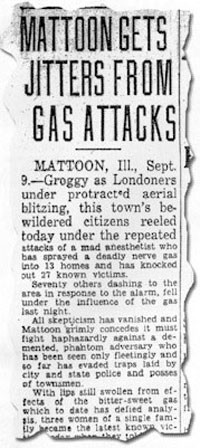For several weeks in September 1944, people in the town of Mattoon, Illinois, showed the symptoms of exposure to poison gas--nausea, vomiting, weakness leading to near paralysis, light headedness, even spitting up blood. All of the victims reported a "sweet cheap perfume odor" permeating their homes prior to the onset of sickness.
Scott Maruna, a high school chemistry and physics teacher in Jacksonville, explains the terror in his book, The Mad Gasser of Mattoon: Dispelling the Hysteria (Swamp Gas Book Co., 2003).
This case has long been cited in college psychology classes as a perfect example of mass hysteria. Occurring during World War II, when so many men were off fighting and so many women were left alone, the gassings have been explained away as the product of paranoia, panic, and delirium.
But Maruna dispels this idea, giving credence to many who came forward to report a smell coming through their windows at night, and in some cases seeing a shadowy figure running into the darkness.
Within 48 hours, four homes had been hit and the newspaper headlines blared, "Anesthetic Prowler on the Loose." The evenings were sultry, forcing people to leave open their windows. On subsequent nights, several more homes were "hit."
Maruna's 100-page book presents the facts surrounding the cases, the police investigations, and similar events in other cities across the United States. He then looks at the episode as a perfect example of hysteria. When police led people to believe the reports were mistaken, suddenly calls to the station dropped, possibly, Maruna suggests, from sheer "embarrassment"--and perhaps because the police chief threatened "to arrest anyone else who reported a gassing without submitting to a medical examination." This alone, Maruna says, deterred people from admitting they'd been gassed.
Maruna then examines 11 traits common to mass hysteria, providing factual details to subvert each of these characteristics. For example, most mass hysteria cases involve women, as did the Mattoon gassings. Maruna logically explains, though, that during the height of WW II Mattoon would have naturally had more women in residence; therefore, the victims would obviously include more females.
In the end, Maruna presents his solution. He dismisses the 60-year-old claim of mass hysteria and points to a real person as the culprit. Living in Mattoon was a town genius who could be found with "his nose buried in books" at his family's grocery store. Farley Llewellyen drank too much, kept a secret laboratory, and experimented with various chemicals. Once, an explosion from his lab rocked the neighborhood. Maruna says, "Farley, the obvious chemical genius behind the gas's synthesis, was the real gasser. In a fit brought on by mental instability and years of pent-up rage against a town that would not and could not accept him, Farley tinkered and toyed with various organic solvents in an attempt to create for a suitable weapon." Maruna even goes so far as to identify Farley's chemical as tetrachlorethane, a chemical with all the properties to induce the symptoms reported in the gassings.
The Mad Gasser of Mattoon is an interesting, easy read that presents compelling arguments for Farley as the "mad gasser." Hats off to Scott Maruna for an intriguing book.


